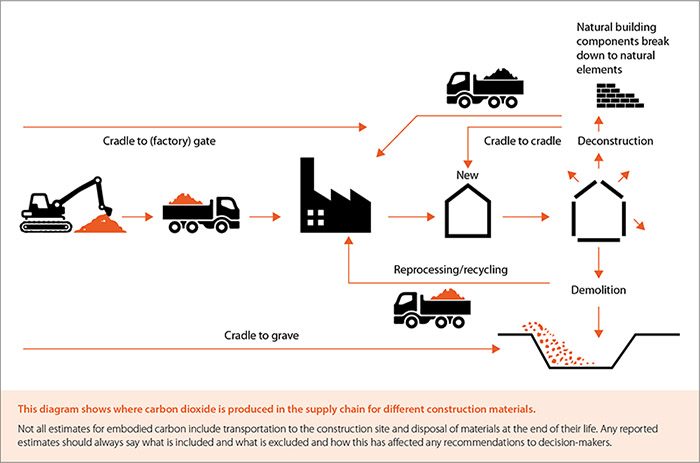Reducing Embodied Carbon in New Construction or Renovation
By Amy Johns, Senior Strategy Consultant
If your organization wants to reduce embodied carbon in your building projects, what can you do? That depends on your project.
Are you planning new construction of renovation? Renovations vary tremendously in scope. The closer a renovation gets to a “full gut”, the closer the embodied carbon emissions become, when comparing renovation with comparable new construction. Code-required improvements, deep energy retrofits and fixing structural problems in older buildings can all increase embodied carbon in a renovation. New construction can almost always achieve higher levels of energy efficiency than renovations, so the life cycle climate impact of the choices can become quite close.
Which is preferable from a climate perspective—new construction or renovation?
The best way to know is to perform a life cycle carbon scenario analysis of both. This is complicated, since the choice between new construction and renovation is often made well before there’s enough of a design to really do a life cycle analysis. You can solve this problem several ways:
- Establish baseline “new construction” and “renovation” embodied carbon estimates based on recent construction or industry standards. While not as precise as an actual design, they’re probably good enough to allow for comparison. In this case, either be clear with your design team about how to construct the baselines, do that work internally or use a separate consultant.
- If embodied carbon is a high priority, delay the decision about renovation or new construction until after each possibility has enough clarity to allow for full life cycle analysis (likely after schematic design). This is a fairly precise method, but expensive, since it requires carrying two separate designs through schematic design. Be clear with your design team that you expect a life cycle carbon scenario analysis at the end of schematic design, and that you expect both designs to be carried that far.
- Ultimately, you may even decide to base the decision on renovation or new construction on other factors, while committing to prioritizing low-carbon construction in the chosen scenario. Depending on the project, careful decisions in either a renovation or new construction may be more important for climate impact than whether you undertake one or the other.
Graphic from UCL Engineering, “Refurbishment and Demolition of Housing Embodied Carbon: Fact Sheet”
How Can We Best Reduce Embodied Carbon?
The biggest carbon impact comes from decisions made fairly early in the design process.
The highest impact choices are:
- How big is the building? The smaller the structure, the lower the embodied carbon.
- What’s the construction type? Wood structures are much lower in embodied carbon than steel-and-concrete.
- How much glass is there? Glass is high in embodied carbon (and glass has a lower R-value than walls, so isn’t great for operating energy either).
A right-sized wood structure with sufficient (but not excessive) amounts of glass is much lower carbon than a huge curtain wall steel-and-concrete building.
How Can Owners Ensure a Low-Embodied Carbon Project?
Choosing a team that is genuinely engaged in reducing embodied carbon will make all other steps easier.
- Hire design and construction teams with experience in delivering low-carbon building projects.
- Include both embodied carbon analysis and low-carbon design in qualifications
- Ask detailed, well-informed questions during the interview process
- Be clear internally about whether that experience is a deal-breaker in hiring
- Be clear about what you’re asking for in a project—address the issue in the RFP/RFQ.
- If you’re debating between new construction and renovation, be clear both internally and with your design team about which assessment method you’re using (see above).
- If you know that your project is new construction, either ask outright for low carbon construction type (dictate wood structure and appropriate glass) or ask for scenario life cycle carbon analysis of possible structure types and glass percentages.
- If you know that your project is renovation, embodied carbon is less likely to drive decision making, since the basic structure, glass percentage and size are already determined. If there’s a substantial addition, follow the recommendations above for new construction.
- Be willing to push back on designs that are not low carbon. Ideally, you’ve hired a design team that proactively presents you with low-carbon designs, but if you haven’t, then reject designs with soaring glass atriums, lots of curtain wall and concrete.
- Consider carbon pricing as a way of balancing embodied carbon concerns with other priorities in the project. Many decisions that impact embodied carbon are low cost, save money or are difficult to cost. What, for example, is the cost of making an early design choice to reduce glass? Carbon pricing can be used, especially later in design, to prioritize low carbon choices of individual materials.
Amy Johns, IES senior strategy consultant, is the former director of the Zilkha Center for Environmental Initiatives at Williams College. She has worked in the environmental sector for more than fifteen years.
Copyright © Integrated Eco Strategy, LLC



